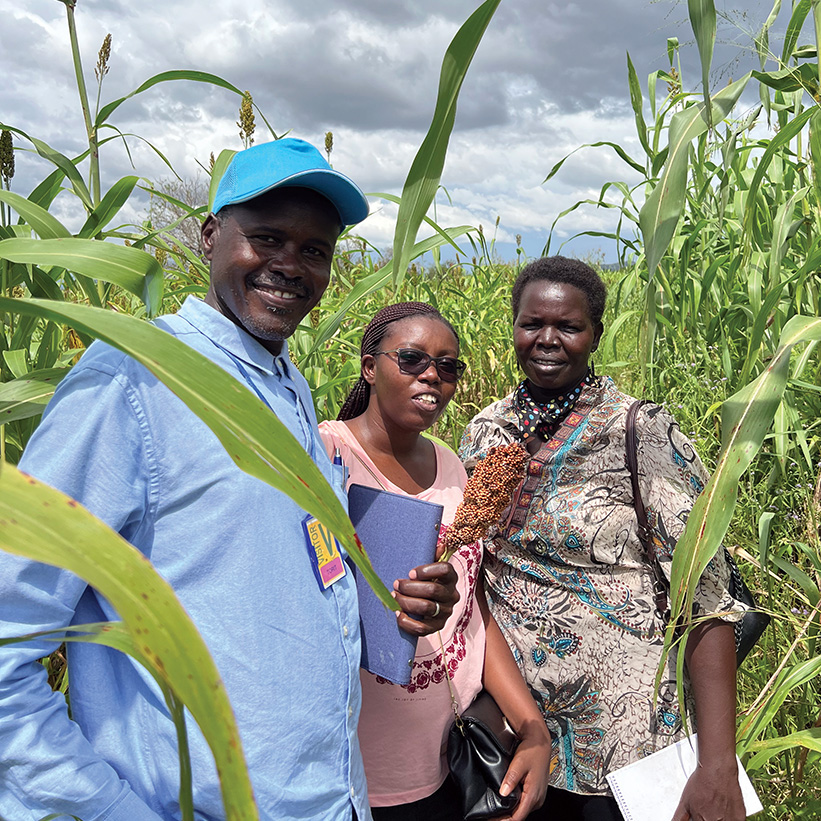South Sudan at 13: Reflections on Crisis, Aid, and the Road to Recovery
The situation in South Sudan points to the strategic importance of moving from humanitarian aid to long-term development and resilience-building.
BY JULIUS KAUT

A worker unloads bags of sorghum for distribution to vulnerable people in Aweil East county in northern South Sudan to stave off anticipated famine, June 2024.
Julius Kaut
In July 2024, South Sudan, the world’s youngest nation, marked its 13th year of independence. Though observed, this year’s Independence Day was celebrated quietly for the most part, with few funds available for official festivities. The initial euphoria of 2011 has largely dissipated, and in 2024 the nation is grappling with numerous challenges, including a serious economic crisis characterized by hyperinflation and skyrocketing food prices.
In the meantime, the civil war that broke out in 2013 between South Sudan President Salva Kiir and Vice President Riek Machar, the leaders of the two largest ethnic groups, concluded in August 2018 with a cease-fire and power-sharing agreement, and the two formed a unity government in 2020. But implementation of the 2018 peace agreement has been slow and halting. Though the government extended the transition period, initially scheduled to end in February 2023, to February 2025, critical issues such as security arrangements and electoral preparations have not yet been dealt with.
Though not engaged in a civil war anymore, South Sudan remains in crisis and vulnerable, and its dependence on humanitarian aid has blocked off avenues for economic development. As donor fatigue grips governments and major international institutions, it is essential that South Sudan’s leadership and its international partners work together to move toward sustainable development and self-reliance.
Economic Pressures and Political Uncertainty
A major driver of recent economic challenges in this landlocked country has been the conflict that erupted in April 2023 in its northern neighbor Sudan, through which South Sudan exports most of its oil. The war in Sudan has disrupted the flow of oil, and revenues, into the state treasury. Instead, it has brought a wave of refugees and returnees into South Sudan, further straining the country’s already limited resources and conditions of humanitarian crisis.
Also significant, the young nation’s first elections are scheduled to take place in December, after having been repeatedly postponed for many years. In a nation that is home to some 64 ethnicities, the elections are expected to replace temporary peace agreements with a more permanent resolution, paving the way for lasting peace and sustainable development. But with December only a few months away, there is widespread uncertainty whether the elections will be held.
This is a critical point of concern. A priority for parts of the international community that have pressured Juba to schedule them, the elections are meant to be a milestone in South Sudan’s democratic journey. Yet because basic preparations are still lacking and no census has been conducted, there are fears that elections might either trigger new conflicts or fail to take place altogether. Critics argue that fundamental conditions for a fair election are not in place.
Local peace initiatives and ongoing dialogues involving national and state leaders show a commitment to working toward reconciliation and stability in the country.
From taxi drivers, students, and waiters to international aid workers and academics, opinions are divided on the potential outcome. While some fear that holding elections might trigger new conflicts, others worry that not holding elections could have the same effect. There are concerns that 2024 might see a widespread deterioration in the security situation, similar to what the country experienced between 2013 and 2018, although this scenario has fortunately not materialized yet.
At the same time, among young people in Juba, connected to smartphones and social media as they are, the U.S. election, and the potential return of a candidate who rejected the outcome of the last presidential election, is one of the most discussed topics. They are watching closely; and in the view of some, the U.S. as an intervening international body is losing credibility.
Whether or not the elections take place, it is possible that 2024 will pass without major escalations in conflict. Though the political elites in Juba are still divided, and still prefer not to share power, they also learned lessons from the past. A return to civil war is not a preferred option for either party. Memories of the brutal civil war years, which buried many hopes for the young nation’s quick development and traumatized many South Sudanese, are still vivid. Most do not wish to return to such a state of conflict. While competition for power and communal and inter-ethnic violence remain threats, they are currently mostly limited to localized incidents, and the situation now in South Sudan is far from the civil war–like situations of the past.
Some politicians are working toward peace and stability. Local peace initiatives and ongoing dialogues involving national and state leaders show a commitment to working toward reconciliation and stability in the country. Some of these initiatives might be very localized, yet they have an impact and are dependent on the political buy-in of politicians, which is given in some areas of the country.

A village in Torit county in the state of Eastern Equatoria, southeast of Juba, June 2023.
Julius Kaut
The Aid Dependence Trap
The truth, however, is that South Sudan remains in perpetual crisis. The absence of stability and peace is still the primary challenge for the country, underpinning many other issues such as food insecurity and hunger. The food security situation is dire, with many people relying on food aid, despite the country’s fertility and abundant resources. South Sudan is home to the River Nile and the second-largest animal migration in the world. Yet the hungry population depends on aid, as does the economy as a whole.
The United States, among other countries, has not only provided significant amounts of aid to the South Sudanese but also played an important role in the country’s journey since independence. American diplomatic efforts were crucial in brokering the Comprehensive Peace Agreement in 2005, which eventually led to South Sudan’s independence in 2011. And the U.S. remains the largest donor of humanitarian aid to the country, supporting millions of South Sudanese through food assistance, health and education services, and other initiatives.
Humanitarian aid is a significant contributor to South Sudan’s GDP—not only providing essential services, but generating substantial employment (estimated at 10 percent of overall employment). In a country characterized by an otherwise dramatic lack of employment and extremely low wages—where a police officer earns as little as $3 per month, and wages haven’t been paid in more than six months—the aid industry and its periphery are a crucial lifeline for many.
Despite the billions of dollars invested, however, South Sudan’s progress has been glacial, and the country’s stability remains precarious. Though a lifeline for many, humanitarian aid also poses challenges. Originally meant to alleviate immediate suffering during crises, continuous aid during South Sudan’s protracted crisis has affected local markets and mindsets. Markets are heavily influenced and sometimes damaged by prolonged aid. Over time people have learned to respond strategically to food security assessments and to manipulate standard methodologies to maximize their chances of receiving aid, whether needed or not, which, in turn, affects the local economy.
Further, the effect of large, sustained quantities of aid on conflict dynamics in a country or region is another question that is coming under investigation. There are still significant gaps in understanding aid’s impact on conflict dynamics, with limited empirical evidence and data from South Sudan for informed decision-making.
Time for a Development Reset?

A research team stands in a sorghum field in Eastern Equatoria, South Sudan, November 2022. The field excursion is part of a multistakeholder dialogue on food system resilience.
Julius Kaut
Still, the realization that good intentions do not always result in good assistance implementation is growing. Despite many years and billions of dollars in aid, South Sudan continues to rank poorly on major indicators such as GDP, education, life expectancy, stability, freedom, infrastructure, and basic services—the country came in at 192 of 193 on the 2022 UN Human Development Index. This phenomenon of limited returns on aid investments has contributed to decreased funding and heightened competition among aid organizations.
Coupled with the severe economic crisis and looming elections, however, a drop in donor funding might constitute an opportunity for South Sudan to seize the moment and reclaim control. Currently, aid organizations manage many government responsibilities, including education, health, infrastructure, and aid for the poor. As this support wanes, the government and people of South Sudan have a unique chance to assume greater responsibility and take the initiative. It would be beneficial for Western partners to collaborate with South Sudan on a strategic transition plan, empowering the nation to achieve greater self-sufficiency.
Many will argue that South Sudan is not yet ready and that humanitarian aid is the only viable form of assistance in such a fragile context. They maintain that humanitarian aid is the most appropriate response in the face of hunger and, at times, potential famine. This perspective reflects what could be labeled the “humanitarian reflex”—that is, to jump into business-as-usual mode at the sign of crisis, and repeat the same initiatives over and over again, despite their contested effectiveness. Today, after years of mixed success with humanitarian projects, it is time to shift from humanitarian assistance to long-term development and resilience-building.
This year may be ideal for this transition in South Sudan because previous interventions have laid the foundations for sustainable progress. South Sudan can now capitalize on the current relative stability to invest in systems and infrastructure that empower communities, promote self-reliance, and address root causes of vulnerability. A significant challenge here might be aligning the interests of the various countries providing aid in South Sudan to act in an organized joint effort rather than with limited coordination and competing interests that is otherwise typical.
Indeed, some international nongovernmental organizations have already begun experimenting with novel approaches, such as partnering with local universities to strengthen food system resilience. These and other initiatives are creating momentum and opportunities for dialogue and change.
Building a Brighter Future
After many experiences in this country—some frustrating, others inspiring—I remain optimistic and hopeful. South Sudan, which many aren’t even aware is an independent nation, is full of young people with potential and a vision for the future of their nation. (About half of the country’s 12.7 million population is under the age of 18.) They live in a sparsely populated land rich in natural resources and full of raw materials.
Some say that South Sudan has the potential to overcome its current calorie deficit and to feed all of East Africa, if peace is achieved and agricultural production scaled. And peace is, indeed, what is needed, along with a phased, but determined, reduction of humanitarian aid to enable and encourage the people to cultivate their lands again.
Shaping the future is first and foremost a task for the South Sudanese. However, the West and the United States have an important supporting role to play in this transition. American support has been crucial to South Sudan since its independence, and now, the focus should shift toward fostering sustainable development and self-reliance.
By primarily supporting initiatives co-created with the South Sudanese that promote education, infrastructure, and economic development, while phasing out humanitarian aid where possible, the U.S. and partners can help South Sudan build a more stable and prosperous future. I am convinced that with the right support and a strategic exit from dependencies on aid, this country can have a bright future.
While South Sudan faces significant challenges, there is hope. The country’s future depends on its ability to navigate challenges and build a foundation for lasting peace and development. The coming months will be crucial in determining the direction of this young nation for the years to come.
When sharing or linking to FSJ articles online, which we welcome and encourage, please be sure to cite the magazine (The Foreign Service Journal) and the month and year of publication. Please check the permissions page for further details.
Read More...
- “A Closer Look at Advancing World Food Security” by Michael McClellan, The Foreign Service Journal, October 2015
- “Development Aid to Africa: Time for Plan B?” by Don Lotter, The Foreign Service Journal, April 2016
- “Food Systems Resilience Dialogue and Pathway Development, Eastern Equatoria State - South Sudan” by Gerrit-Jan van Uffelen et al., Wageningen Centre for Development Innovation, March 2023





